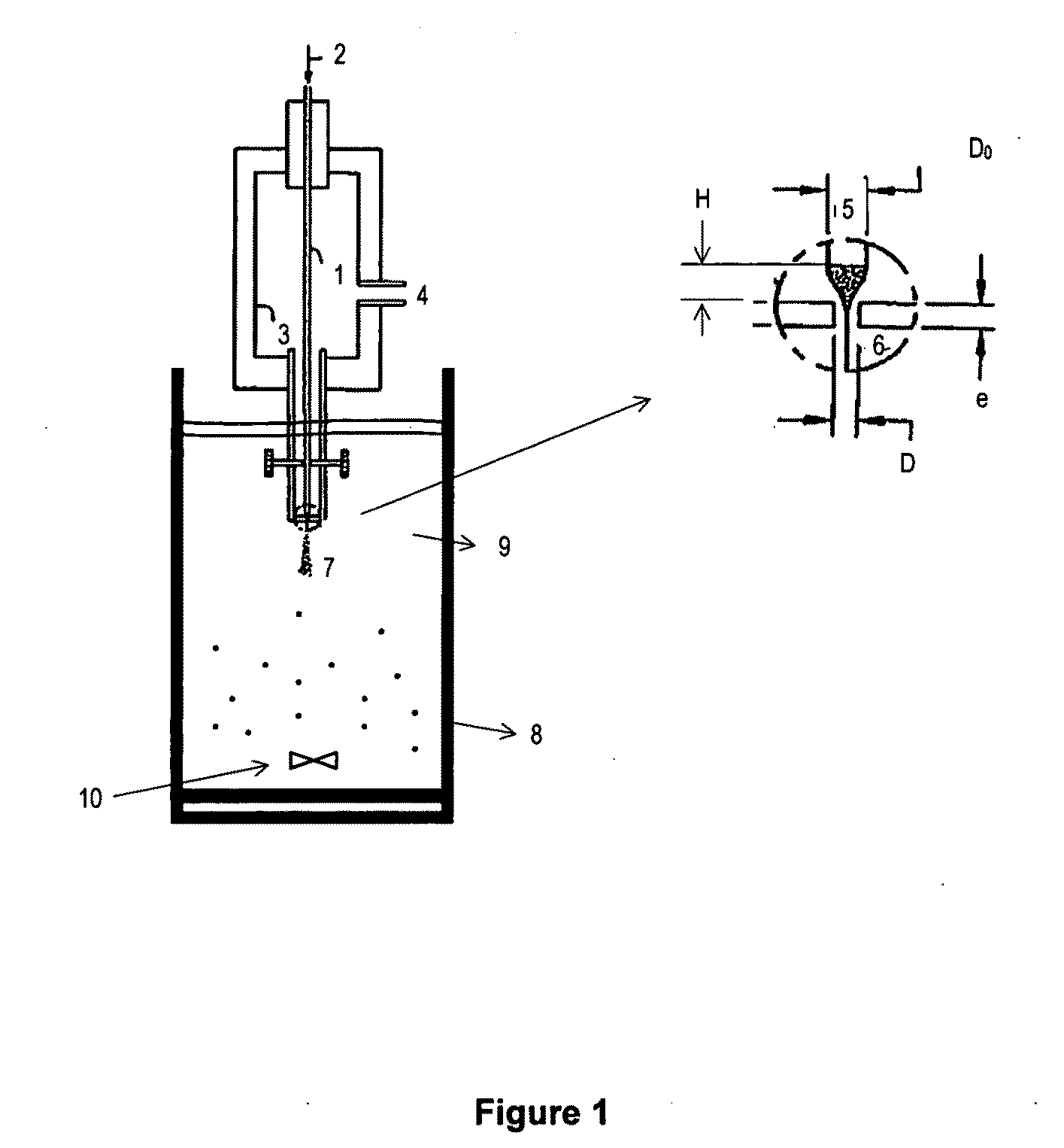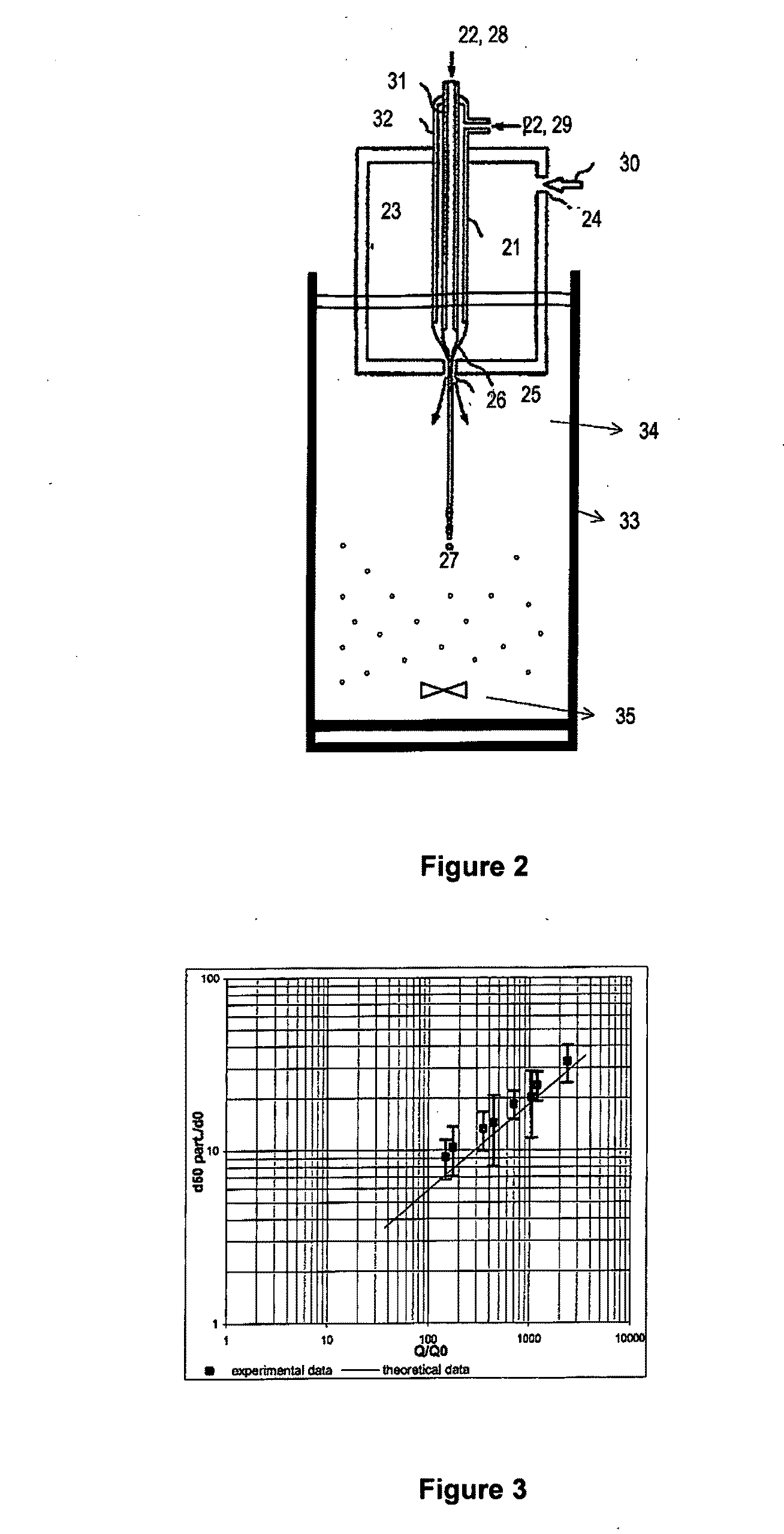Method and Device for Obtaining Micro and Nanometric Size Particles
a micro- and nano-sized particle technology, applied in chemical methods analysis, instruments, manufacturing tools, etc., can solve the problems of increasing the cost of the analysis technology, the complexity of the sample preparation protocol, and the disadvantages of traditional microarrays that have not yet been solved, so as to achieve high usable surface, high versatility in application, and convenient storage
- Summary
- Abstract
- Description
- Claims
- Application Information
AI Technical Summary
Benefits of technology
Problems solved by technology
Method used
Image
Examples
example 1
Preparation of 5 Micron Polystyrene Microparticles (FIG. 4a)
[0114]The following example shows the procedure for producing 5 micron polystyrene microparticles using the methodology described in this invention. The generation of the emulsion takes place using a capillary flow focussing device (D=100 μm) with one single feeding end (D0=H=150 μm). The device for capillary flow focussing is immersed in a stirred 1% w / v PVA aqueous solution under stirring. Through the feeding tube we inject a 4% w / v polystyrene dissolution (Aldrich, Mw=4.000-200.000) in ethyl acetate (Panreac Chemistry) with 1 mL / h flow rate. The chamber is pressurized by means of the introduction of water with a 3 mL / min continuous flow rate. The generated o / w emulsion is kept under stirring during 16 h at room temperature so the extraction / evaporation of the solvent takes place. Solid particles are centrifuged (Orto Alresa mod. Digicen 20, 4.000 rpm, 10 min), washed three times in water, lyophilized and stored at 4° C.
[...
example 2
Preparation of 9 Micron Polystyrene Microparticles (FIG. 4b)
[0116]The following example shows the procedure for producing 9 micron polystyrene microparticles using the methodology described in this invention. It uses the same device for capillary flow focussing as in example 1. The procedure for obtaining microparticles and composition of the fluids are the same as described in example 1, changing only the fluids injection conditions. The polymer dissolution is injected with 2 mL / h flow rate of and the water flow rate is 2 mL / min.
[0117]The analysis of the microparticles was made using an optical microscope (Leica DM LS) and an image editor program (daverage 9.28 □m, DS 0.86) and a scanning electron microscope (Philips XL30) (FIG. 4b).
example 3
Production of 13 Micron Polystyrene Microparticles
[0118]The following example shows the procedure for producing 13 micron polystyrene microparticles using the methodology described in this invention. The generation of the emulsion takes place using a capillary flow focussing device (D=200 μm) with one single feeding tube (D0=H=150 μm). The device for capillary flow focussing is immersed in a 1% w / v PVA aqueous dissolution under stirring. Through the feeding tube we inject a 4% w / v polystyrene solution (Aldrich, Mw=4.000-200.000) in dichloromethane (Aldrich) with 3 mL / h flow rate. The chamber is pressurized by means of the introduction of water with a 4 mL / min continuous flow rate. The generated o / w emulsion is kept under stirring during 16 h at room temperature so the extraction / evaporation of the solvent takes place. Solid particles are centrifuged (Orto Alresa mod. Digicen 20, 4.000 rpm, 10 min), washed three times in water, dried by introducing it in boiling bath of water and sto...
PUM
| Property | Measurement | Unit |
|---|---|---|
| Fraction | aaaaa | aaaaa |
| Fraction | aaaaa | aaaaa |
| Fraction | aaaaa | aaaaa |
Abstract
Description
Claims
Application Information
 Login to View More
Login to View More - R&D
- Intellectual Property
- Life Sciences
- Materials
- Tech Scout
- Unparalleled Data Quality
- Higher Quality Content
- 60% Fewer Hallucinations
Browse by: Latest US Patents, China's latest patents, Technical Efficacy Thesaurus, Application Domain, Technology Topic, Popular Technical Reports.
© 2025 PatSnap. All rights reserved.Legal|Privacy policy|Modern Slavery Act Transparency Statement|Sitemap|About US| Contact US: help@patsnap.com



